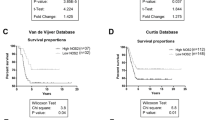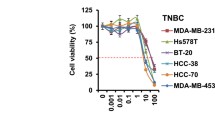Abstract
Increased expression of nitric oxide synthase (NOS) is associated with different cancers such as cervical, breast, lung, brain, and spinal cord. Inhibition of NOS activity has been suggested as potential tool to prevent breast cancer. The anti-tumor therapeutic effect of L-nitro arginine methyl ester (L-NAME), NOS inhibitor, using in vivo models is currently under investigation. We hypothesized that L-NAME will show an anti-tumor effect by delaying a progression of breast cancer via a modulation of cell death and proliferation, and angiogenesis. We used a novel model of anti-cancer treatment by the administration of L-NAME (30 mg/kg in a day, intraperitoneal) injected every third day for five weeks to rat model of 7,12-dimethylbenz[a]anthracene (DMBA)-induced breast tumor. Concentrations of nitrite anions, polyamines, malondialdehyde, NH4+ levels, and arginase activity in the blood were decreased in DMBA + L-NAME-treated rats compared with DMBA rats. The mortality rates, tumor number, weight, and volume, as well as the histopathological grade of breast cancer were also significantly reduced. In addition, L-NAME treatment showed a delay in tumor formation, and in body weight compared with rats administrated only with DMBA. In conclusion, our data show that L-NAME is a promising anti-cancer agent to treat breast cancer, which can lead to development of anti-tumor therapeutic tools in future.







Similar content being viewed by others
Data availability
All data generated or analyzed during this study are included in this published article.
Abbreviations
- L-NAME:
-
L-nitro arginine methyl ester
- cGMP:
-
Cyclic guanosine monophosphate
- DMBA:
-
7,12-Dimethylbenz[a]anthracene
- NO:
-
Nitric oxide
- NOHA:
-
NG-hydroxy-L-Arginine
- NOS:
-
Nitric oxide synthase
- eNOS:
-
Endothelial NOS
- iNOS:
-
Inducible NOS
- nNOS:
-
Neuronal NOS
- VEGF:
-
Vascular endothelial growth factor
- MMP:
-
Matrix metalloproteinases
- TLC:
-
Thin-layer chromatography
- IP:
-
Intraperitoneal administration
- MDA:
-
Malondialdehyde
- IDP:
-
Intraductal proliferations
- D:
-
DMBA group
- DL:
-
DMBA + L-NAME group,
- SCC:
-
Spindle cell carcinoma,
- ILC:
-
Invasive lobular carcinoma
- PC – G1:
-
Papillary carcinoma grade 1
- SC:
-
Sarcomatoid carcinoma
- TC:
-
Tubular carcinoma
- PLBC:
-
Pleomorphic lobular breast cancer,
- IDC:
-
Invasive ductal carcinoma
- VEGF:
-
Vascular endothelial growth factor
References
Bray F, Ferlay J, Soerjomataram I et al (2018) Global cancer statistics 2018: GLOBOCAN estimates of incidence and mortality worldwide for 36 cancers in 185 countries. CA Cancer J Clin 68:394–424. https://doi.org/10.3322/caac.21492
Sun YS, Zhao Z, Yang ZN et al (2017) Risk factors and preventions of breast cancer. Int J Biol Sci 13:1387–1397. https://doi.org/10.7150/ijbs.21635
Morris SM (2012) Arginases and arginine deficiency syndromes. Curr Opin Clin Nutr Metab Care 15:64–70. https://doi.org/10.1097/MCO.0b013e32834d1a08
Pershing NLK, Yang C-FJ, Xu M, Counter CM (2016) Treatment with the nitric oxide synthase inhibitor L-NAME provides a survival advantage in a mouse model of Kras mutation-positive, non-small cell lung cancer. Oncotarget 7:42385–42392. https://doi.org/10.18632/oncotarget.9874
Avtandilyan N, Javrushyan H, Petrosyan G, Trchounian A (2018) The involvement of arginase and nitric oxide synthase in breast cancer development: arginase and NO synthase as therapeutic targets in cancer. Biomed Res Int 2018:1–9. https://doi.org/10.1155/2018/8696923
Burke AJ, Sullivan FJ, Giles FJ, Glynn SA (2013) The yin and yang of nitric oxide in cancer progression. Carcinogenesis 34:503–512. https://doi.org/10.1093/carcin/bgt034
Bonavida B (2015) Nitric Oxide and Cancer: Pathogenesis and Therapy. Springer International Publishing Switzerland
Keshet R, Erez A (2018) Arginine and the metabolic regulation of nitric oxide synthesis in cancer. Dis Model Mech 11:1–11. https://doi.org/10.1242/dmm.033332
Suksawat M, Techasen A, Namwat N et al (2018) Inhibition of endothelial nitric oxide synthase in cholangiocarcinoma cell lines - a new strategy for therapy. FEBS Open Bio 8:513–522. https://doi.org/10.1002/2211-5463.12388
Xue Q, Yan Y, Zhang R, Xiong H (2018) Regulation of iNOS on immune cells and its role in diseases. Int J Mol Sci. https://doi.org/10.3390/ijms19123805
Vanini F, Kashfi K, Nath N (2015) The dual role of iNOS in cancer. Redox Biol 6:334–343. https://doi.org/10.1016/j.coph.2011.03.009
Ahmad R, Sah AK (2017) Nitric Oxide Molecule and Human Cancers. Int J Biochem Physiol 2:000110
Chioda M, Marigo I, Mandruzzato S et al (2013) Arginase, Nitric Oxide Synthase, and Novel Inhibitors of L-arginine Metabolism in Immune Modulation. Elsevier, Second Edi
Rath M, Müller I, Kropf P et al (2014) Metabolism via arginase or nitric oxide synthase: Two competing arginine pathways in macrophages. Front Immunol 5:1–10. https://doi.org/10.3389/fimmu.2014.00532
Vahora H, Khan MA, Alalami U, Hussain A (2016) The potential role of nitric oxide in halting cancer progression through chemoprevention. J Cancer Prev 21:1–12. https://doi.org/10.15430/JCP.2016.21.1.1
Nakamura Y, Yasuoka H, Tsujimoto M et al (2006) Nitric oxide in breast cancer: Induction of vascular endothelial growth factor-C and correlation with metastasis and poor prognosis. Clin Cancer Res 12:1201–1207. https://doi.org/10.1158/1078-0432.CCR-05-1269
Surh YJ, Chun KS, Cha HH et al (2001) Molecular mechanisms underlying chemopreventive activities of anti-inflammatory phytochemicals: Down-regulation of COX-2 and iNOS through suppression of NF-κB activation. Mutat Res - Fundam Mol Mech Mutagen 480–481:243–268. https://doi.org/10.1016/S0027-5107(01)00183-X
Timoshenko AV, Chakraborty C, Wagner GF, Lala PK (2006) COX-2-mediated stimulation of the lymphangiogenic factor VEGF-C in human breast cancer. Br J Cancer 94:1154–1163. https://doi.org/10.1038/sj.bjc.6603067
Timoshenko AV, Lala PK, Chakraborty C (2004) PGE2-mediated upregulation of iNOS in murine breast cancer cells through the activation of EP4 receptors. Int J Cancer 108:384–389. https://doi.org/10.1002/ijc.11575
Wong VC, Lerner E (2015) Nitric oxide inhibition strategies. Futur Sci OA. https://doi.org/10.4155/fso.15.35
Laurindo FRM, Liberman M, Fernandes DC, Leite PF (2018) Endothelium-dependent vasodilation: nitric oxide and other mediators. Elsevier Inc
Yu LB, Dong XS, Sun WZ et al (2005) Effect of a nitric oxide synthase inhibitor NG-nitro-L-arginine methyl ester on invasion of human colorectal cancer cell line SL-174T. World J Gastroenterol 11:6385–6388. https://doi.org/10.3748/wjg.v11.i40.6385
Caneba CA, Yang L, Baddour J et al (2014) Nitric oxide is a positive regulator of the Warburg effect in ovarian cancer cells. Cell Death Dis 5:e1302–e1312. https://doi.org/10.1038/cddis.2014.264
Lampson BL, Kendall SDS, Ancrile BB et al (2012) Targeting eNOS in pancreatic cancer. Cancer Res 72:4472–4482. https://doi.org/10.1158/0008-5472.CAN-12-0057
Munder M (2009) Arginase: An emerging key player in the mammalian immune system: REVIEW. Br J Pharmacol 158:638–651. https://doi.org/10.1111/j.1476-5381.2009.00291.x
Xiong L, Teng JLL, Botelho MG et al (2016) Arginine metabolism in bacterial pathogenesis and cancer therapy. Int J Mol Sci 17:1–18. https://doi.org/10.3390/ijms17030363
Soda K (2011) The mechanisms by which polyamines accelerate tumor spread. J Exp Clin Cancer Res 30:95. https://doi.org/10.1186/1756-9966-30-95
Sellick J (2011) Enhancing the protection of animals used for scientific purposes. Environ Law Manag 23:75–82
Steele VE, Lubet RA, Moon RC (2005) Preclinical animal models for the development of cancer chemoprevention drugs. Cancer Chemoprevention 2:39–46. https://doi.org/10.1016/S0022-3999(00)00150-1
Arroyo-Acevedo J, Chávez-Asmat RJ, Anampa-Guzmán A et al (2015) Protective effect of piper aduncum capsule on DMBA-induced breast cancer in rats. Breast Cancer Basic Clin Res 9:41–48. https://doi.org/10.4137/BCBCR.S24420
Angeline Kirubha SP, Anburajan M, Venkataraman B et al (2012) Evaluation of mammary cancer in 7,12-dimethylbenz(a)anthracene-induced wister rats by asymmetrical temperature distribution analysis using thermography: A comparison with serum Cea levels and histopathology. J Biomed Biotechnol. https://doi.org/10.1155/2012/786417
Alvarado A, Lopes AC, Faustino-Rocha AI et al (2017) Prognostic factors in MNU and DMBA-induced mammary tumors in female rats. Pathol Res Pract 213:441–446. https://doi.org/10.1016/j.prp.2017.02.014
Granados-Principal S, Liu Y, Guevara ML et al (2015) Inhibition of iNOS as a novel effective targeted therapy against triple-negative breast cancer. Breast Cancer Res 17:1–16. https://doi.org/10.1186/s13058-015-0527-x
Reis OTG, Raini JC, Coradi ST, Constantino DHJ (2009) Effect of L-Arginine and L-NAME treatments on polymorphonuclear leukocytes and mononuclear cells influx during tumor growth. Acta Cir Bras 24:107–111. https://doi.org/10.1590/S0102-86502009000200006
Krishnamoorthy D, Sankaran M (2016) Modulatory effect of Pleurotus ostreatus on oxidant/antioxidant status in 7, 12-dimethylbenz (a) anthracene induced mammary carcinoma in experimental rats - A dose-response study. J Cancer Res Ther 12:386. https://doi.org/10.4103/0973-1482.148691
Koch MA (2006) Experimental modeling and research methodology. Lab Rat. https://doi.org/10.1016/B978-012074903-4/50021-2
Sápi J, Kovács L, Drexler DA et al (2015) Tumor volume estimation and quasi- continuous administration for most effective bevacizumab therapy. PLoS ONE 10:1–20. https://doi.org/10.1371/journal.pone.0142190
Lee G, Goosens KA (2015) Sampling Blood from the Lateral Tail Vein of the Rat. J Vis Exp. https://doi.org/10.3791/52766
Russo J, Russo IH (2000) Atlas and histologic classification of tumors of the rat mammary gland. J Mammary Gland Biol Neoplasia 5:187–200. https://doi.org/10.1023/A:1026443305758
Costa I, Solanas M, Escrich E (2002) Histopathologic characterization of mammary neoplastic lesiosn induced with 7,12-dimethylbenz(a)anthracene in the rats. Histopathol Rat Mammary Tumors 126:915–927
Rakha EA, Reis-Filho JS, Baehner F et al (2010) Breast cancer prognostic classification in the molecular era: The role of histological grade. Breast Cancer Res. https://doi.org/10.1186/bcr2607
Vodovotz Y (1996) Modified microassay for serum nitrite and nitrate. Biotechniques 20:390–394
Morgan DML (1997) Polyamine Protocols. Humana Press, Totowa, New Jersey
Zeb A, Ullah F (2016) A simple spectrophotometric method for the determination of thiobarbituric acid reactive substances in fried fast foods. J Anal Methods Chem. https://doi.org/10.1155/2016/9412767
Huizenga JR, Teelkem AW, Tangerman A et al (1998) Determination of ammonia in cerebrospinal fluid using the indophenol direct method. Mol Chem Neuropathol 34:169–177. https://doi.org/10.1007/BF02815078
De Wilt JHW, Manusama ER, Van Etten B et al (2000) Nitric oxide synthase inhibition results in synergistic anti-tumour activity with melphalan and tumour necrosis factor alpha-based isolated limb perfusions. Br J Cancer 83:1176–1182. https://doi.org/10.1054/bjoc.2000.1447
Cyrulnik B (2012) Nitric oxide synthase inhibition by NG-Nitro-L- arginine methyl ester inhibits tumor-induced angiogenesis in mammary tumors. Bull Acad Natl Med 196:1899–1906. https://doi.org/10.1016/s0001-4079(19)31664-4
Kij A, Kus K, Smeda M et al (2018) Differential effects of nitric oxide deficiency on primary tumour growth, pulmonary metastasis and prostacyclin/thromboxane A2 balance in orthotopic and intravenous murine models of 4T1 breast cancer. J Physiol Pharmacol 69:911–919. https://doi.org/10.26402/jpp.2018.6.05
Iwasaki T, Higashiyama M, Kuriyama K et al (1997) N(G)-nitro-L-arginine methyl ester inhibits bone metastasis after modified intracardiac injection of human breast cancer cells in a nude mouse model. Japanese J Cancer Res 88:861–866
Jadeski LC, Chakraborty C, Lala PK (2003) Nitric oxide-mediated promotion of mammary tumour cell migration requires sequential activation of nitric oxide synthase, guanylate cyclase and mitogen-activated protein kinase. Int J Cancer 106:496–504. https://doi.org/10.1002/ijc.11268
Kwon Y (2018) 7, 12-Dimethylbenz [ a ] anthracene increases cell proliferation and invasion through induction of Wnt / b -catenin signaling and EMT process Doi: https://doi.org/10.1002/tox.22560
Koual M, Tomkiewicz C, Cano-Sancho G et al (2020) Environmental chemicals, breast cancer progression and drug resistance. Environ Heal A Glob Access Sci Source 19:1–25. https://doi.org/10.1186/s12940-020-00670-2
Sciacca M, Belgorosky D, Zambrano M et al (2019) Inhibition of breast tumor growth by N(G)-nitro-L-arginine methyl ester (L-NAME) is accompanied by activation of fibroblasts. Nitric Oxide - Biol Chem 93:34–43. https://doi.org/10.1016/j.niox.2019.09.008
Pegg AE (2008) Spermidine/spermine-N1-acetyltransferase: A key metabolic regulator. Am J Physiol - Endocrinol Metab. https://doi.org/10.1152/ajpendo.90217.2008
Acknowledgements
The work was supported by the Science Committee of MESCS RA, in the frames of Basic support to Research Institute of Biology, Yerevan State University, the research project No 19YR-1F042, 20TTSG-1F004, 21T-1F283 and the research grant biochem-2284 from the Yervant Terzian Armenian National Science and Education Fund (ANSEF) based in New York, USA.
Author information
Authors and Affiliations
Contributions
All authors contributed to the study's conception and design. NA, HJ, and MG have carried out the investigations and analyzed the outcomes. NA wrote the manuscript. HJ and MG edited the manuscript. The histological alterations in breast samplings have been done by AK. AT directed the experiments and corrected and reedited the manuscript. All authors read and accepted the final version of the manuscript.
Corresponding author
Ethics declarations
Conflict of interest
The authors have no relevant financial or non-financial interests to disclose.
Ethical approval
Animal research was approved by the National Center of Bioethics (Armenia) and according to regulations outlined in the 2010/63/EU [28].
Additional information
Publisher's Note
Springer Nature remains neutral with regard to jurisdictional claims in published maps and institutional affiliations.
Rights and permissions
About this article
Cite this article
Avtandilyan, N., Javrushyan, H., Ginovyan, M. et al. Anti-cancer effect of in vivo inhibition of nitric oxide synthase in a rat model of breast cancer. Mol Cell Biochem 478, 261–275 (2023). https://doi.org/10.1007/s11010-022-04489-y
Received:
Accepted:
Published:
Issue Date:
DOI: https://doi.org/10.1007/s11010-022-04489-y




